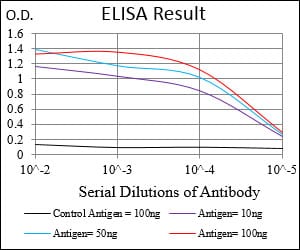
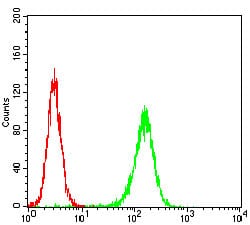
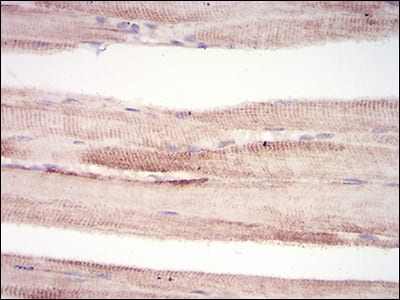
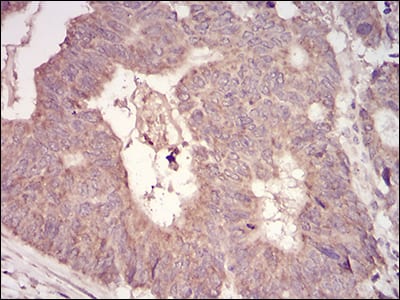
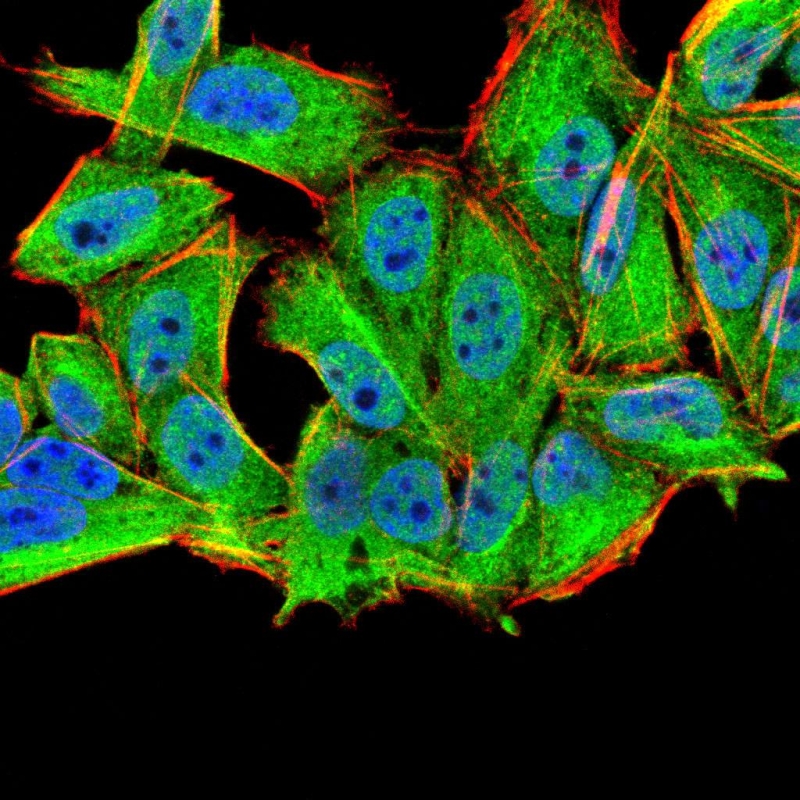
| WB | 咨询技术 | Human,Mouse,Rat |
| IF | 咨询技术 | Human,Mouse,Rat |
| IHC | 1/200 - 1/1000 | Human,Mouse,Rat |
| ICC | 1/200 - 1/1000 | Human,Mouse,Rat |
| FCM | 1/200 - 1/400 | Human,Mouse,Rat |
| Elisa | 1/10000 | Human,Mouse,Rat |
| Aliases | TRIM63; IRF; SMRZ; MURF2; RNF28 |
| Entrez GeneID | 84676 |
| clone | 7B8E1 |
| WB Predicted band size | 40.2kDa |
| Host/Isotype | Mouse IgG1 |
| Antibody Type | Primary antibody |
| Storage | Store at 4°C short term. Aliquot and store at -20°C long term. Avoid freeze/thaw cycles. |
| Species Reactivity | Human |
| Immunogen | Synthesized peptide of human MuRF1 (AA: 293-304). |
| Formulation | Purified antibody in PBS with 0.05% sodium azide. |
+ +
以下是关于MuRF1抗体的3篇代表性文献,包含文献名称、作者及摘要概括:
---
1. **文献名称**:*Identification of ubiquitin ligases required for skeletal muscle atrophy*
**作者**:Bodine, S.C. et al.
**摘要**:该研究通过筛选肌肉萎缩模型中的基因表达,发现MuRF1(E3泛素连接酶)在去神经和糖皮质激素诱导的肌肉萎缩中显著上调。研究中开发了特异性MuRF1抗体,通过Western blot和免疫组化验证其在骨骼肌中的表达定位,证实其参与蛋白酶体依赖的蛋白质降解途径。
2. **文献名称**:*Atrogin-1/MuRF1 inhibits hypertrophy in cultured cardiomyocytes*
**作者**:Kadoshima-Yamaoka, K. et al.
**摘要**:本文利用MuRF1抗体研究其在心肌细胞肥大中的作用。通过免疫沉淀和免疫荧光技术,发现MuRF1通过泛素化降解收缩蛋白(如肌球蛋白),抑制病理性心肌肥厚。抗体特异性经siRNA敲低实验验证,证实其在心脏组织中的应用可靠性。
3. **文献名称**:*Antibody-based profiling of MuRF1 ubiquitination in cachexia*
**作者**:Cohen, S. et al.
**摘要**:研究开发了一种高亲和力MuRF1单克隆抗体,用于检测癌症恶病质模型中肌肉组织的泛素化水平。通过质谱和竞争性结合实验验证抗体特异性,并揭示MuRF1在肿瘤诱导的肌肉消耗中通过靶向特定肌原纤维蛋白促进降解。
---
以上文献均涉及MuRF1抗体的开发或应用,涵盖骨骼肌、心肌及疾病模型,重点验证抗体特异性及功能机制研究。如需扩展,可补充针对特定疾病(如慢性肾病、败血症)的研究文献。
MuRF1 (Muscle RING-finger protein-1) is a key E3 ubiquitin ligase involved in muscle protein degradation through the ubiquitin-proteasome system (UPS). It belongs to the TRIM protein family and is predominantly expressed in striated muscle. MuRF1 plays a central role in muscle atrophy by tagging contractile proteins, such as myosin heavy chains, for proteasomal breakdown. Its expression is upregulated under catabolic conditions like fasting, denervation, disuse, cancer cachexia, and sepsis, making it a biomarker for muscle wasting.
Antibodies targeting MuRF1 are essential tools for studying its expression, localization, and interactions in muscle pathology. They are widely used in techniques like Western blotting, immunohistochemistry, and immunoprecipitation to investigate MuRF1's regulatory mechanisms. Specificity and validation across species (human, mouse, rat) are critical due to potential cross-reactivity with other TRIM proteins. Both monoclonal and polyoclonal antibodies are available, each offering distinct advantages in sensitivity and application scope.
Research on MuRF1 antibodies has advanced understanding of muscle atrophy pathways, aiding drug development for conditions like sarcopenia, muscular dystrophy, and critical illness myopathy. Recent studies also explore its roles in cardiac muscle remodeling and metabolic regulation, highlighting its therapeutic potential beyond skeletal muscle disorders.
×